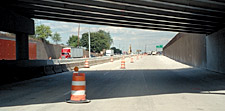Design and Construction Strategies

As our highway infrastructure ages and congestion increases, transportation agencies must find ways of building and reconstructing roads and bridges while limiting impacts to the traveling public. Several design and construction strategies and technologies can be used to save time and cost, and provide a better, safer driving experience during construction.
Accelerated Construction
Accelerated construction uses various techniques and technologies to help reduce construction time while enhancing/maintaining safety and quality.
Coordinating Road Projects
Coordination of road projects between transportation agencies, utilities, and other agencies that need to do construction in the public right-of-way can result in benefits such as significant cost savings, earlier identification of project impacts and greater ability to reduce and manage traffic disruptions from road work, and better quality road surfaces.
Design-Build
Design-Build combines design and construction into one contract and coordinated process, speeding up project delivery and leveraging resources and innovation. Safety and mobility can benefit when work zone considerations are explicitly included.
Night Work/Off-Peak Work
Night work/off-peak work involves scheduling work at periods of lower traffic volumes, to reduce traffic disruption, as well as worker exposure to traffic and driver exposure to work zones.
Positive Protection
Positive protection can reduce the risk to workers and travelers with the use of devices that contain and redirect vehicles, reducing the risk of vehicle intrusion into the workspace.
Road Closure and Lane Closure
Road closure is an approach designed to eliminate the exposure of motorists to work zones and workers to traffic by temporarily closing a facility for rehabilitation or maintenance.
Additional Resources
- Road Safety at Work Zones (PDF 1.3MB) - Report, developed by the European Transport Safety Council, that discusses improving safety for motorists and workers in work zones. Section 2.1 of the report discusses how designing roads that require little to no future maintenance, using asset management to maintain existing roads, and using smart maintenance techniques such as prefabricated materials and rapid replacement techniques, can reduce the number of work zones and therefore minimize the risk to workers and motorists.
- Construction Peer Network - A collaboration among the American Association of State Highway and Transportation Officials (AASHTO), American Road and Transportation Builders Association (ARTBA), Associated General Contractors of America (AGC), and FHWA that brings practitioners together to discuss more effective construction practices and learn from each other's experiences. An article in the June 2012 issue of Focus describes the CPN and summarizes the first peer exchange.
- Use of Exposure Control Measures - Summarizes the various types of exposure control measures and discusses how each can improve the safety of workers and motorists in work zones.
- An Expert Systems Approach to Highway Construction Scheduling (PDF 4.2MB) - Illinois Center for Transportation report presenting the results of research to help create more realistic construction schedules for Illinois DOT projects. The research led to a software tool to help designers develop schedules for typical highway construction activities.
- NCHRP Synthesis 413: Techniques for Effective Highway Construction Projects in Congested Urban Areas (PDF 5.1MB) - Identifies strategies and successful practices used by transportation agencies to deal effectively with the challenges and impacts of construction projects in congested urban corridors.
- Journal of the Transportation Research Board No. 2151: Construction 2010, Volume 1 - Includes 12 papers that explore topics such as quantifying savings for rapid bridge construction technique, effects of project cost reduction methods, roadway construction sustainability impacts, and performance-based contractor prequalification.
- NCHRP Report 658: Guidebook on Risk Analysis Tools and Management Practices to Control Transportation Project Costs (PDF 4.5MB) - Presents a systematic process to apply risk analysis tools and management practices to aid State highway Agency management in controlling transportation project cost growth.
- Highways for LIFE Program - FHWA program to accelerate the adoption of innovations that achieve longer-lasting highway infrastructure and the fast construction of efficient and safe highways and bridges. An article in the January/February 2010 issue of Public Roads describes the program and provides examples of projects that have benefited from the program.
- Construction Project Administration and Management for Mitigating Work Zone Crashes and Fatalities: An Integrated Risk Management Model (PDF 1.4MB) - Examines ways to mitigate the risk of highway accidents and fatalities in work zones and presents a formal risk management model that can be used to identify, assess, and respond to risks across all stages of a project.
- Presentations from Conference on Transportation Construction Management, February 10-12, 2009 - Held to discuss new challenges and solutions in successful transportation project delivery. An article in the July 2009 issue of Focus provides more information about the conference.
- Highway Construction Coordination to Minimize Traffic Impacts (PDF 1MB) - NCHRP report with examples of coordinated highway construction projects and recommendations for agencies interested in implementing enhanced construction coordination while maintaining reasonable levels of traffic flow.
- NCHRP Synthesis 372: Emerging Technologies for Construction Delivery (PDF 3.9MB) - Explores five emerging technologies for transportation construction: global positioning systems for layout, machine guidance, and quantity tracking; handheld computers for construction records; automated temperature tracking for concrete maturity monitoring; four-dimensional computer-aided drafting modeling for constructability analysis and improved communications; and web-based video cameras for remote project monitoring.
- NHCRP Report 581: Design of Construction Work Zones on High-Speed Highways (PDF 3.5MB) - Explores an approach for selecting an appropriate work zone type, offers guidance for geometric design; and examines ancillary features (e.g., drainage, lighting, surface type). A work zone prediction model (XLS 890KB) and user's guide (PDF 64KB) were created to help estimate free-flow vehicle speeds for single lane closures and median crossovers on four lane freeways.
- Assessment and Allocation for Highway Construction Management (PDF 9.5MB) - Guide to the risk assessment and allocation process in highway construction.
PDF files can be viewed with the Acrobat® Reader®
XLS files can be viewed with the Microsoft Excel Viewer.
